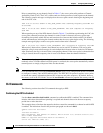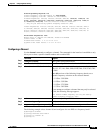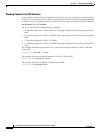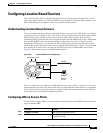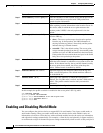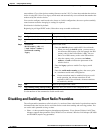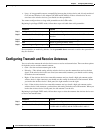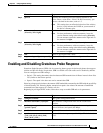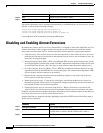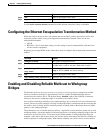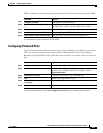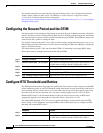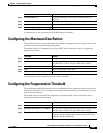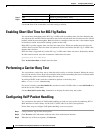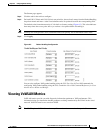
6-26
Cisco IOS Software Configuration Guide for Cisco Aironet Access Points
OL-11350-01
Chapter 6 Configuring Radio Settings
Disabling and Enabling Aironet Extensions
The optional parameters can be configured independently or combined when you do not want to use the
defaults, as shown in the following examples:
(config-if)# probe-response gratuitous period 30
(config-if)# probe-response gratuitous speed 12.0
(config-if)# probe-response gratuitous period 30 speed 12.0
Use the no form of the command to disable the GPR feature.
Disabling and Enabling Aironet Extensions
By default, the wireless device uses Cisco Aironet 802.11 extensions to detect the capabilities of Cisco
Aironet client devices and to support features that require specific interaction between the wireless
device and associated client devices. Aironet extensions must be enabled to support these features:
• Load balancing—The wireless device uses Aironet extensions to direct client devices to an access
point that provides the best connection to the network based on factors such as number of users, bit
error rates, and signal strength.
• Message Integrity Check (MIC)—MIC is an additional WEP security feature that prevents attacks
on encrypted packets called bit-flip attacks. The MIC, implemented on both the wireless device and
all associated client devices, adds a few bytes to each packet to make the packets tamper-proof.
• Cisco Key Integrity Protocol (CKIP)—Cisco's WEP key permutation technique based on an early
algorithm presented by the IEEE 802.11i security task group. The standards-based algorithm, TKIP,
does not require Aironet extensions to be enabled.
• Repeater mode—Aironet extensions must be enabled on repeater access points and on the root
access points to which they associate.
• World mode (legacy only)—Client devices with legacy world mode enabled receive carrier set
information from the wireless device and adjust their settings automatically. Aironet extensions are
not required for 802.11d world mode operation.
• Limiting the power level on associated client devices—When a client device associates to the
wireless device, the wireless device sends the maximum allowed power level setting to the client.
Disabling Aironet extensions disables the features listed above, but it sometimes improves the ability of
non-Cisco client devices to associate to the wireless device.
Aironet extensions are enabled by default. Beginning in privileged EXEC mode, follow these steps to
disable Aironet extensions:
Step 6
end Return to privileged EXEC mode.
Step 7
copy running-config startup-config (Optional) Save your entries in the configuration file.
Command Purpose
Command Purpose
Step 1
configure terminal Enter global configuration mode.
Step 2
interface dot11radio { 0 | 1slot/port
}
Enter interface configuration mode for the radio interface. The
2.4-GHz radio is radio 0, and the 5-GHz radio is radio 1.
Step 3
no dot11 extension aironet Disable Aironet extensions.



